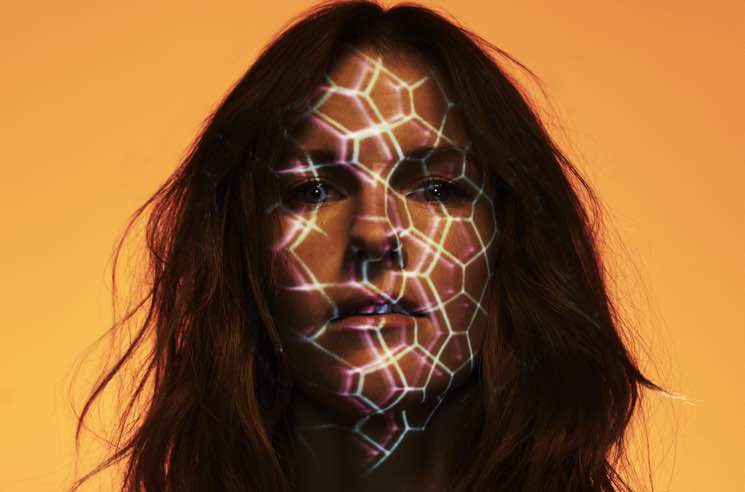In the busy hands of L.A.-based synthesist and composer Kaitlyn Aurelia Smith, rare hardware synthesizers unlock rich, vibrant universes highly evocative of fertile natural environments — vivid, arpeggio-driven explorations that search adventurously through breathing realms defined by synthetic approximations of nature and studied wildlife sounds.
Her latest, The Kid, is an ambitious double album that soundtracks an existential coming-of-age arc. Each side represents a distinct stage in cognitive-emotional development: innocence and confusion, becoming self-aware, forging identity and reaching wisdom and peace.
Picking up where 2016's EARS left off, it resumes Smith's more prominent use of (frequently vocoder-harmonized) vocals and acoustic accompaniment, this time working with the EU-based Stargaze Quartet, with Smith supplying arrangements for bassoon, cello, clarinet, flute and trumpet.
"I wanted it to feel sonically heavier, darker, sludgier — more clumsy in the beginning and have a gradient as you go through the stages to finally reaching purely orchestral or lighter in colour and lighter in feeling of the rhythms — like more sophisticated arrangements," Smith explains. "As the album goes on, the compositions get more clear, more sophisticated, and not as clumsy and spastic with their rhythms. In the beginning of the album, the orchestral stuff is still there, but it's very processed and hidden."
Smith insists the album isn't an autobiographical undertaking, but it remains another document of her continued growth as an artist.
"I've been asking myself where I am, and I feel like I'm still in that stage of seeking everything for self-discovery, but I'm also starting to want to put a lot of my thoughts into, like, 'How can I use this self-discovery to [give back]?'" Smith reflects. "When I'm alone in nature, that's when I get my clarity of who I am and what I'm doing."
One particular meditative dronescape, "Who I Am & Why I Am Where I Am," is a more personal reflection. "I made [that piece] after spending some time alone in New Zealand, and I wanted to create a feeling of lots of animal life around you. And I guess that's my personal part of it.
"I do feel personally that as I get older, I get more comfortable with not knowing, and have less of a fire to be like 'I have to know,'" says Smith. "I don't know anything at all, and this creation is not a statement of knowing anything. It's also not a solid belief, either. It's just an experiment, I guess."
Her latest, The Kid, is an ambitious double album that soundtracks an existential coming-of-age arc. Each side represents a distinct stage in cognitive-emotional development: innocence and confusion, becoming self-aware, forging identity and reaching wisdom and peace.
Picking up where 2016's EARS left off, it resumes Smith's more prominent use of (frequently vocoder-harmonized) vocals and acoustic accompaniment, this time working with the EU-based Stargaze Quartet, with Smith supplying arrangements for bassoon, cello, clarinet, flute and trumpet.
"I wanted it to feel sonically heavier, darker, sludgier — more clumsy in the beginning and have a gradient as you go through the stages to finally reaching purely orchestral or lighter in colour and lighter in feeling of the rhythms — like more sophisticated arrangements," Smith explains. "As the album goes on, the compositions get more clear, more sophisticated, and not as clumsy and spastic with their rhythms. In the beginning of the album, the orchestral stuff is still there, but it's very processed and hidden."
Smith insists the album isn't an autobiographical undertaking, but it remains another document of her continued growth as an artist.
"I've been asking myself where I am, and I feel like I'm still in that stage of seeking everything for self-discovery, but I'm also starting to want to put a lot of my thoughts into, like, 'How can I use this self-discovery to [give back]?'" Smith reflects. "When I'm alone in nature, that's when I get my clarity of who I am and what I'm doing."
One particular meditative dronescape, "Who I Am & Why I Am Where I Am," is a more personal reflection. "I made [that piece] after spending some time alone in New Zealand, and I wanted to create a feeling of lots of animal life around you. And I guess that's my personal part of it.
"I do feel personally that as I get older, I get more comfortable with not knowing, and have less of a fire to be like 'I have to know,'" says Smith. "I don't know anything at all, and this creation is not a statement of knowing anything. It's also not a solid belief, either. It's just an experiment, I guess."
